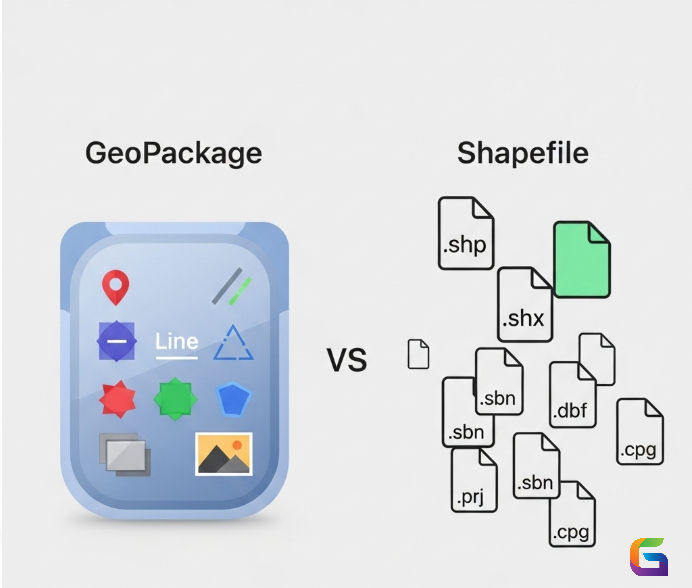GeoPackage vs. Shapefile: Choosing the right format for your GIS data
- Anvita Shrivastava

- Aug 9
- 3 min read
You will often come across many file formats for managing and storing your spatial information when working with Geographic Information Systems (GIS) data. Shapefiles and GeoPackage are two of the most popular. You can choose the best format for your needs by being aware of its advantages and disadvantages.

Shapefiles
Esri created the well-known and conventional Shapefile format. They are renowned for their ease of use and wide range of compatibility with many GIS software programs.
Strengths:
Broad Support: Shapefiles are a popular option for data integration and interchange because practically every GIS software supports them.
Simplicity: Even for novices, its simple structure—which consists of several files—makes it easy to comprehend and work with.
Open Standard: Because Shapefiles are an open standard, there are no license restrictions, and they are not restricted to any one software provider.
Weaknesses:
Several File Management: When working with several datasets, managing the various files that make up a Shapefile dataset, such as.shp,.shx,.dbf, etc.—can be challenging.
Size Restrictions: Shapefiles can only contain 2GB of data per file, which may be a problem for very big datasets and necessitate dividing data into several sets.
Restricted Attribute Support: According to Towards Data Science, attribute field names can only contain ten characters and have inadequate support for Unicode characters.
Lack of Support for Raster Data: Shapefiles are mainly made for vector data and are unable to hold raster data, such as digital elevation models or satellite imagery.
Limited Support for Metadata: Shapefiles have limited capacity to store metadata inside the dataset, which might make it difficult to determine the quality and provenance of the data.
GeoPackage
The Open Geospatial Consortium (OGC) created the more recent, open, and standards-based GeoPackage format, which stores and manages vector and raster data in a single file using a SQLite database.
Strengths:
Single File Format: GeoPackage makes data administration, sharing, and transfer easier by storing all data (vector, raster, attributes, and metadata) in a single file.
Huge Storage Capacity: GeoPackage is appropriate for applications that surpass the 2GB limit since it can manage huge datasets without the size constraints associated with Shapefiles.
Versatile Data Support: GeoPackage offers a more thorough representation of spatial information in a single file by storing a variety of data formats, such as raster, tiled, and vector features.
Unicode Support: International characters and scripts are appropriately stored and presented thanks to GeoPackage's integrated Unicode support.
Integrated Metadata: It provides strong metadata storage features right in the file, including crucial details about the data source, how it was collected, and more.
Performance: Because of features like R-tree spatial indexing for quicker queries, GeoPackages frequently perform better than Shapefiles, particularly when dealing with huge datasets.
Weaknesses:
Adoption Rate: Although GeoPackage is a relatively new format, some older or specialized GIS software may not yet fully support it, despite its quick adoption.
Complexity: Users used to the more straightforward Shapefile format may find the more complex features and capabilities of GeoPackage to have a higher learning curve.
For tasks involving both vector and raster data, big datasets, multilingual data, integrated metadata, and when you wish to take advantage of contemporary GIS features and future-proof your data, go with GeoPackage.
Select Shapefile for rapid data exchanges with wide compatibility, for simple vector data without complicated relationships, or when working with legacy systems or software that might not currently support GeoPackage.
Many of the drawbacks of the conventional Shapefile format are being addressed by GeoPackage, which is becoming a more effective and flexible format for organizing and storing spatial data. Nonetheless, the GIS community still uses both formats, and by being aware of their unique advantages, you can choose the one that will work best for your project.
For more information or any questions regarding GeoPackage and Shapefile, please don't hesitate to contact us at
Email: info@geowgs84.com
USA (HQ): (720) 702–4849
(A GeoWGS84 Corp Company)




Comments